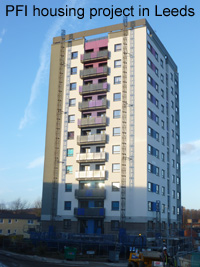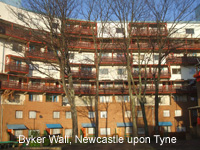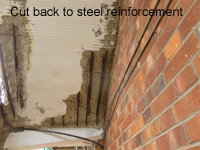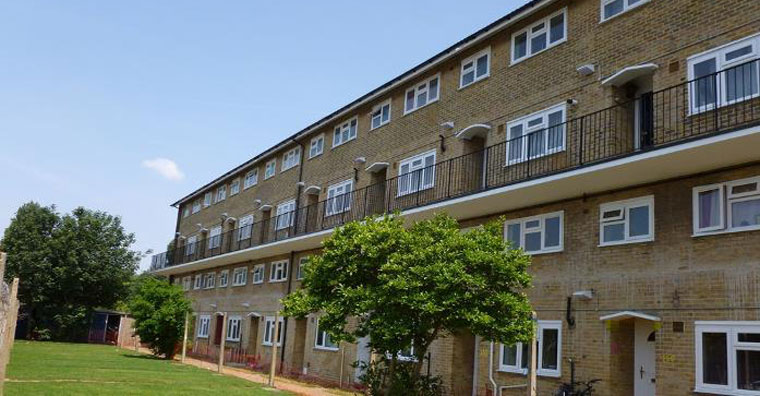When it comes to the refurbishment of social housing, external coatings can play a key role in enhancing the outside appearance of residential properties whilst extending their design life. Graham James OBE of Flexcrete Technologies Limited and Matthew Gillborn of the Gunite Group explain further.
There are many options available to suit all budgetary and technical specifications but one of the most important factors to consider, especially on high rise accommodation blocks, is the harmful effects of carbonation. Carbonation is without question one of the most common forms of deterioration of concrete buildings, whereby carbon dioxide from the atmosphere reacts with the concrete, leading to a loss of alkalinity and subsequent corrosion of the reinforcing steel. All reinforced concrete structures are affected by carbonation virtually from the day they are built, so need protection in order to avoid expensive repair and maintenance work down the line.
of carbonation. Carbonation is without question one of the most common forms of deterioration of concrete buildings, whereby carbon dioxide from the atmosphere reacts with the concrete, leading to a loss of alkalinity and subsequent corrosion of the reinforcing steel. All reinforced concrete structures are affected by carbonation virtually from the day they are built, so need protection in order to avoid expensive repair and maintenance work down the line.
Another key factor to consider when selecting a suitable product is that walls need to breathe. Rain saturated walls rely on wind action and sunshine to dry them out, but this can be in short supply, especially in the winter months. If walls cannot breathe, then moisture vapour builds up behind the coating, leading to blistering or flaking in the paint or coating, especially under freeze/thaw conditions. A damp substrate is also an ideal breeding ground for unsightly algae and mould growth.
Advantages of Decorative Anti-Carbonation Coatings
Leading manufacturers offer a range of weatherproof, anti-carbonation coatings which provide ultimate protection against carbonation, atmospheric chemicals and water ingress, whilst allowing damp substrates to breathe without blistering. For social housing projects, it is advantageous to use coatings which have water-based, low VOC (Volatile Organic Content), low hazard formulations. These do not release hazardous solvents or strong odour during application, which needs to be taken into account in residential areas. It is also beneficial to use rapid drying coatings, as some will allow two coat applications on the same day, even in the inclement weather conditions. This is an important consideration for projects where disruption needs to be minimised for residents.
Various finishes and technical specifications are available, including external wall coatings with smooth finishes or textured finishes for hiding surface defects and imperfections. High performance products also have elastomeric formulations and are capable of withstanding thermal and structural movement without cracking or flaking, and some coatings incorporate an active in-film fungicide which inhibits the growth of mould, fungi and lichens.
Coatings manufacturers generally offer a range of decorative colours and special colours can be made to order, so it is possible to match a specific RAL or BS colour or to match an existing substrate. Pigmented anti-carbonation coatings will redecorate a tired façade, but anti-carbonation coating technology is also available as a transparent finish to preserve the original appearances of buildings. With lifespans of up to 15 years before first maintenance, high performance coatings can considerably extend the life expectancy of both new and existing buildings.
High performance external wall coatings have been used on housing refurbishment projects all around the UK to provide effective anti-carbonation protection and there are products available whereby a coating DFT (Dry Film Thickness) of 130µm is equivalent to 500mm of good quality concrete. Anti-carbonation coatings are often specified in conjunction with a range of concrete repair and protection materials and are applied as a final decorative finish once the original substrate has been repaired.
Social Housing Refurbishment Projects
 External coatings work has been carried out as part of a major exterior renovation contract on the Byker Wall, a Grade II listed building on the Byker Estate in Newcastle upon Tyne. The exterior of approximately 400 flats and maisonettes have been refurbished, including the replacement of windows, doors and rooves. Repairs were carried out to the concrete of the external walls and balcony soffits, before the area was protected with an anti-carbonation coating with a smooth finish totalling some 2,500m². Keeping disruption to a minimum was vital and a user friendly, rapid drying coating was specified.
External coatings work has been carried out as part of a major exterior renovation contract on the Byker Wall, a Grade II listed building on the Byker Estate in Newcastle upon Tyne. The exterior of approximately 400 flats and maisonettes have been refurbished, including the replacement of windows, doors and rooves. Repairs were carried out to the concrete of the external walls and balcony soffits, before the area was protected with an anti-carbonation coating with a smooth finish totalling some 2,500m². Keeping disruption to a minimum was vital and a user friendly, rapid drying coating was specified.
Large scale refurbishment work is also currently being undertaken on a major PFI housing project in Leeds. Sustainable communities for Leeds (sc4L) is a group of organisations formed specifically to deliver the project, all working in partnership with Leeds City Council to build new council homes, refurbish existing council properties and regenerate communities in Little London, Beeston Hill and Holbeck.
Concrete repair materials, including over 50 tonnes of a low density repair mortar, and a cost-effective anti-carbonation coating have been used for the repair and protection of window cills, balcony areas and ring beams on six large tower blocks in Leeds. An anti-carbonation coating has been applied to selected areas of concrete in a range of special ‘accent’ colours such as Signal Violet and Traffic Red. Three tower blocks – Carlton Close, Carlton Croft and Carlton Garth – have been coated and a further three are currently underway, namely Oatland Court, Oatland Heights and Oatland Tower.
An anti-carbonation coating has also been used as the waterproof decorative protection of the soffits on five tower blocks on the Cock Hill Estate in Rubery, Birmingham. Approximately 3,500m² of external coatings work has been carried out on Dowery House, Hillside House, Quarry House, Redworth House and Rushmore House as part of a major refurbishment project for Birmingham City Council. In this case, a 10 year coating system was specified in white.
Further south, coatings work has been undertaken on a project at Jeremy’s Green on the outskirts of Edmonton, North London for the London Borough of Enfield. Jeremy’s Green is a residential housing complex containing 176 flats, apartments and maisonettes in blocks of two and three storeys. The oldest properties were built in the 1950’s and the concrete soffits and balconies had previously been protected with a coating that had badly deteriorated over time.
At Jeremy’s Green, in order to keep disruption, noise and debris to a minimum, it was a special requirement that the selected  fairing coat could effectively bond to the existing coated concrete to level out imperfections in the crazed surfaces. Following repairs and levelling, an anti-carbonation coating with a textured finish was applied as the first coat. A smooth coating was then applied as the top coat for the desired finish. The chosen system transformed the appearance of the balconies and soffits and will provide waterproof and anti-carbonation protection for at least 15 years.
fairing coat could effectively bond to the existing coated concrete to level out imperfections in the crazed surfaces. Following repairs and levelling, an anti-carbonation coating with a textured finish was applied as the first coat. A smooth coating was then applied as the top coat for the desired finish. The chosen system transformed the appearance of the balconies and soffits and will provide waterproof and anti-carbonation protection for at least 15 years.



